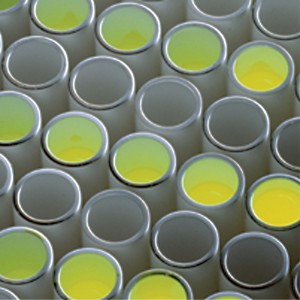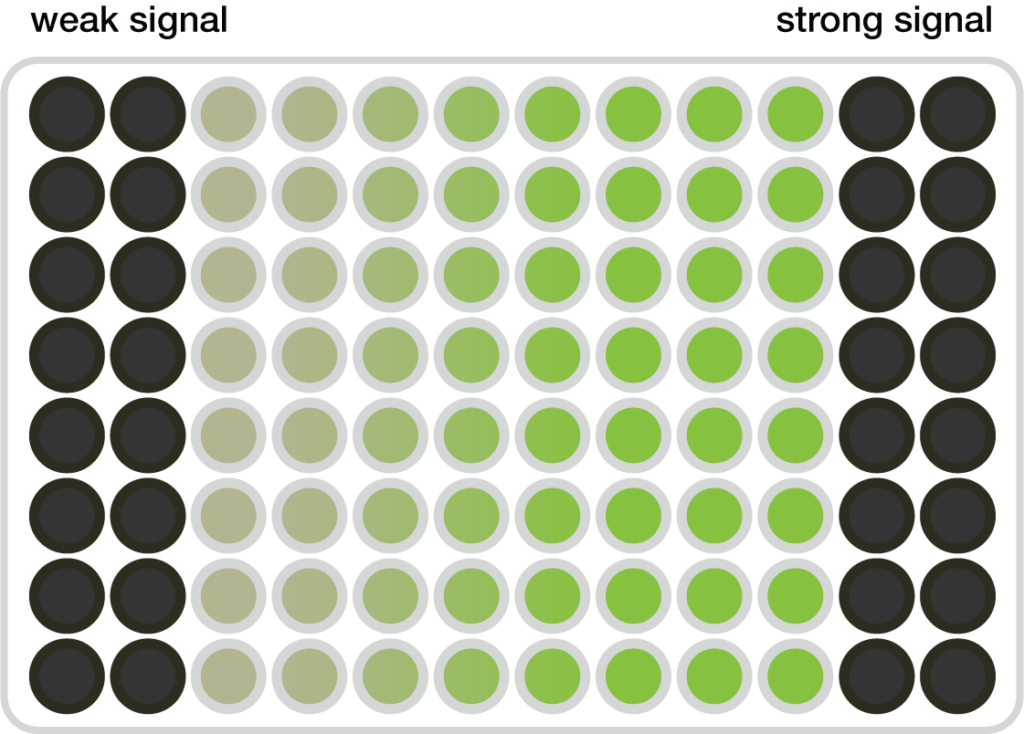
Each luminescent assay plate represents precious time, effort and resources. Did you know that there are three things about your detection instrument that can impact how much useful information you get from each plate? Instruments with poor sensitivity may cause you to miss low-level samples that could be the “hit” you are looking for. Instruments with a narrow detection range limit the accuracy or reproducibility you needed to repeat your work. Finally, instruments that let the signal from bright wells spill into adjacent wells allow crosstalk to occur and skew experimental results, costing you time and leading to failed or repeated experiments.
Sensitivity: You Shouldn’t Have to do Extra Work Because of Your Instrument
Some instruments require a gain adjustment, which controls voltage to the detector, making it more or less sensitive based on the signal coming from the well. Once set, this gain adjustment applies to every sample within the microplate being measured. For instruments claiming to have “auto-gain” adjustment, the gain must be set manually before subsequent “auto” adjustments can occur. With these instruments, if the signal from even one well is too intense it can saturate the detector. When this happens, you must lower the gain for the entire microplate. This means less intense samples within that microplate will also be read using the same gain setting, even if it is not optimal for their signal. Conversely, if the signal on the plate is too weak, then the gain must be adjusted to intensify the signal. If you don’t adjust the gain, you will lose the signal for those wells in the noise and risk missing important “hits”.

But what if you have both ends of the intensity spectrum on the same microplate? How do you set the gain? If you set the gain in the middle to capture most of the weakest samples and most of the highest samples, you are sacrificing the results for the samples at both extremes. If you set the gain for the weakest samples you are accepting that some of the most intense samples will saturate the detector and not give an accurate measurement. When the gain is set to capture the most intense signals, you will miss the low-level signals. All of this manipulation adds uncertainty each time you perform your experiment.
The solution to this conundrum is a true, bona fide “auto-gain” that provides the optimal adjustment for every sample, both weak and intense, within the same microplate. True auto-gain adjustment, like that offered by GloMax® Instruments means that the gain is automatically adjusted in real time for each and every sample measured, without any manual intervention. This ensures confidence you are achieving the best possible results.
Learn more about sensitive detection of luminescent assays in this article.
Detection Range: You shouldn’t have to Change Your Experimental Design to Accommodate Your Instrument
With experimental samples, you cannot always predict which one will give you low or high signals. You still need your assay results to be both accurate and reproducible. If your instrument has a narrow detection range you might need to guess what assay conditions are needed when you prepare your experiment. If your samples saturate the detector, you will need to rework your experiment and hope they are now in the proper range. If your samples are below the detection range of the instrument you might not be able to distinguish them from the background noise, and you will either never detect them, or you will have to change your experimental design somehow and repeat the assay.

Instruments with a broad detection range can read signals at the low and high end, assuring that your assay results are accurate across your plate without further manipulation. In particular, Glomax® Instruments can measure intense and weak signals to allow you to perform your experiments near physiological levels.
Crosstalk: You Shouldn’t Have to Worry that Your Instrument is Reading Signal from Neighboring Wells
It is difficult to always know which experimental samples will give intense signals and which will give weak ones. This can make setting up your experimental plate a guessing game. For most plate readers an intense signal often ends up crossing over into the adjacent wells. When that happens it can influence your conclusions because your results are not accurate. How much this will impact your assays depends upon how much crosstalk your plate reader allows.

To avoid this, you could design your experiment so that there are blank wells between your samples; however, this greatly reduces the number of samples you can measure per plate. It also forces you to design your experiment around the performance of your plate reader. The GloMax® Instruments have a dual-masking design that gives you a true result for every well and eliminates the concern of crosstalk signal contamination.
Learn more about how you can avoid crosstalk in this article.
Conclusion
A lot of time and effort goes into every assay plate. The last thing you should worry about is missing out on important experimental results because your detection instrument is not performing at the level you need. Don’t let these three common issues limit your assay results. Choosing the right instrument will give you confidence that your assay results will be accurate and reliable.
Latest posts by Promega (see all)
- Immune Surveillance Meets Innovation: The Critical Need for dsRNA Detection - April 22, 2025
- Beyond Ozempic: The New Frontier of Obesity Research - April 18, 2025
- One Health and H5N1: Promega’s Commitment to Holistic Solutions - April 8, 2025

Sorry, disagree with the auto-gain adjustment on a per well basis. How will you compare samples to each other and controls if each well is read with a different PMT gain setting? Bad science.
Hi HD,
Thank you for your comment.
The GloMax® Instruments use a proprietary method that linearly adjusts the gain so that results can still be compared across the entire plate.
Kelly
did this method really work? what i found out is that sometimes my sample reading is lower than the background. but with other readers, i never see this happens.
Hello, We find that this method works very well and is reliable. If you have questions about the performance of your instrument our technical services team is happy to help troubleshoot any instrument or chemistry concerns that you may have. You can reach out to technical services on our website here: https://www.promega.com/support/
Hi Kelly,
So you said that the results are comparable across the entire plate, but how about different plates?
Hi Emma,
Good question. The way the GloMax instruments detect and processes data is consistent; if you read the same plate multiple times in quick succession you will get consistent RLU values for each well (using a glow-type assay). However, due to the increased number of potential variables that can occur between plates in a multi-plate assay, we recommend as best practice including replicate(s) of a positive control on each plate that you can use as a calibrator.
If you have more question about these instruments and our glow assays, you can reach out to our technical services team here: https://www.promega.com/support/
Kelly
This is an unhelpful page. For each potential problem, the only solution appears to be buying a GloMax device. This is not practical. A more balanced analysis (which would be expected from a large company like Promega) would have given more practical solutions to some of the highlighted problems instead of just plugging the GloMax devices.